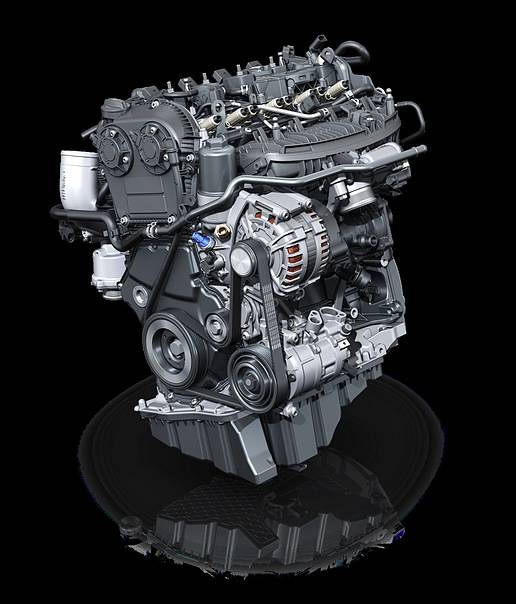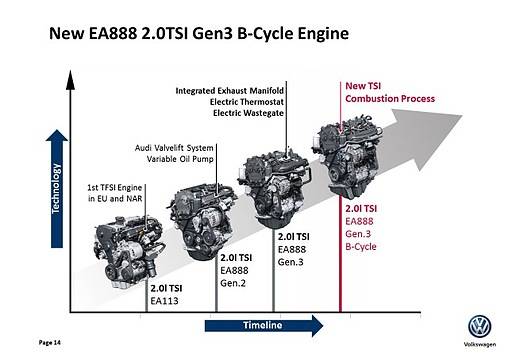 大众汽车推出 EA888 Gen3B 全新发动机。其中,B 代表大众汽车先进动力系统研发工程师 Ralf Budack 的姓氏首字母。
大众汽车推出 EA888 Gen3B 全新发动机。其中,B 代表大众汽车先进动力系统研发工程师 Ralf Budack 的姓氏首字母。 目前,大众汽车广泛使用的EA888 涡轮增压直喷 4 缸发动机系列又新增了一款明星产品——第三代 B 循环发动机 EA888 Gen3B。
目前,大众汽车广泛使用的EA888 涡轮增压直喷 4 缸发动机系列又新增了一款明星产品——第三代 B 循环发动机 EA888 Gen3B。 EA888 Gen3B 发动机的独特凸轮轴调整机制,可以延迟关闭进气门,这也是 B 循环概念的核心。
EA888 Gen3B 发动机的独特凸轮轴调整机制,可以延迟关闭进气门,这也是 B 循环概念的核心。 EA888 Gen3B 发动机的气缸盖设计几乎与 EA888标准 2.0L 发动机没有任何相似之处。
EA888 Gen3B 发动机的气缸盖设计几乎与 EA888标准 2.0L 发动机没有任何相似之处。 大众的 EA888 Gen3B 发动机实现了“驾驶员”时速范围内的能效提升。
大众的 EA888 Gen3B 发动机实现了“驾驶员”时速范围内的能效提升。
大众汽车 (Volkswagen) 的畅销产品EA888 4 缸汽油发动机系列新添又一明星产品——全新 B 循环发动机 EA888 Gen3B。尽管没有明确说明,但大众汽车似乎有意让这款发动机接替未来将退出北美市场的高效柴油发动机。
大众汽车将全新EA888发动机第三代称为“B 循环”架构,是因为B 代表大众汽车先进动力系统研发工程师 Ralf Budack 的姓氏首字母。多年以来,Budack 一直在努力研究如何结合目前越来越受欢迎的阿特金森循环和米勒循环燃烧过程,通过延迟关闭进气门缩短压缩行程,增长膨胀行程。
在此背景之下,这款 2.0L EA888 Gen3B 发动机应运而生。大众汽车表示,与 1.8LTSI 发动机相比, Gen3B 可以取得与前者相同的功率水平,但燃料经济性可以实现 8% 的提升,几乎与小型 1.4L 发动机持平。因此,购车者除了享受到 2.0L发动机比目前的1.8L发动机更大的排量之外,还可以同时获得 1.4L 小型发动机才能达到的燃油效率。EA888 Gen3B 发动机将率先采用于 2018 款全新途观 (Tiguan) 紧凑型跨界车,而后将陆续用于帕萨特 (Passat)、捷达 (Jetta)、高尔夫 (Golf) 和甲壳虫 (Beetle) 等车型。
新型气缸盖与花式凸轮轴设计
在最近一次的媒体见面会上,大众汽车动力系统工程师 Marcel Zirwes 详细介绍了这款发动机的开发细节。Zirwes 表示,虽然新款 B 循环发动机保留了 EA888 的铸铁缸体,但气缸盖设计几乎已经完全不同了。
这款 EA888 Gen3B 发动机的核心技术在于两步式进气凸轮轴设计。具体来讲,新设计采用了一款滑动钝齿,可以实现可变气门正时:发动机可以在需要最大功率时保持正常进气门开启设置,也可以在部分负载条件下,利用凸轮凸角提前关闭进气门,从而实现更长的膨胀行程,这也就是 B 循环的意义所在。
Zirwes 表示,B 循环发动机的进气门机制不仅可以缩短进气门的开启时间,开合幅度也有缩小。
EA888 Gen3B 发动机的全新铝质活塞采用了一种独特的活塞顶和活塞碗设计,可以实现 11.7:1 的高压缩比(相较之下,EA888 Gen3 标准 4缸发动机的压缩比仅为 9.6:1)。这款 B 循环发动机搭配了一款响应速度更快的涡轮增压器,使用常规汽油即可取得最大功率和扭矩。与普通的 2.0L 发动机相比,新款 B 循环发动机还调整了喷嘴的位置,每个燃烧周期中最多可以实现 3 次喷射。
由于采用了张力更低的活塞环设计,新款发动机的摩擦减少了 8% 左右;这种设计在完全负载条件下的平均有效制动压力 (BMEP) 更低,这意味着工程师可以缩小车辆曲柄的主轴承尺寸,以及2 条平衡轴之间的传动链尺寸,进而实现小型化设计。
目前,B 循环发动机为新款途观的唯一发动机配置,4,400 转时可提供 184 hp 马力,与前身 2.0L 发动机相比,可在更低转速时输出峰值功率。具体来说,该款发动机在 1,600转时即可输出最大扭矩 221 lb·ft (300 N·m),并持续保持至4,000 转左右,这与柴油机的水平相仿。尽管与途观目前采用的 2.0L TSI 发动机相比,新款 B 循环发动机的功率输出降低了 200 hp,但扭矩却出人意料地实现了 14 lb·ft (19 N·m) 的提升。
对 2018 款途观而言,目前这款 B 循环发动机仅可搭配大众汽车的 8 速自动变速器。尽管新途观采用了大众汽车的畅销 MQB 汽车架构,但与该架构车型通常搭配的 DSG 手动变速器不同,为了提供更加流畅的驾驶性能,面向北美市场的途观特别采用了传统的自动扭矩转换器设计。
Volkswagen’s not saying it directly, but the company’s unique new twist on its well-established EA888 gasoline 4-cylinder engine family looks to be a potentially effective high-efficiency surrogate for the diesel engines it no longer will sell in North America.
The company calls the new third-generation variant of the AE888 engine architecture “B-Cycle,” so named for its developer, VW group advanced-powertrain engineer Ralf Budack, who for years envisioned this melding of the increasingly popular Atkinson- and Miller-cycle combustion processes that seek to use a truncated compression ratio—via late closing of the intake valves—to achieve an effectively longer expansion ratio.
Resulting is a 2.0-L engine that VW said has the power of the 1.8-L TSI it replaces, but roughly 8% better fuel economy—generating efficiency one might expect from a smaller 1.4-L engine. So in effect, buyers who get the new B-Cycle engine—first in the all-new 2018 Tiguan compact crossover and then the Passat, Jetta and Golf and Beetle—will enjoy 2.0-L displacement in place of today’s 1.8-L, with the added bonus of 1.4-L-like efficiency.
New cylinder head, fancy cam
Although the EA888’s iron cylinder block remains, the new B-Cycle variant has what amounts to an almost entirely new cylinder head design, said Marcel Zirwes, a VW powertrain engineer who detailed the engine’s development during a recent media program.
The central technology for the B-Cycle variant is a two-step intake camshaft that employs a sliding cog to locate the cam on one of two discrete timing regimes: a normal intake-valve opening setup when maximum power is required, or the partial-load setting that angles the cam lobes for the early intake-valve closing that delivers the B-Cycle effects. Zirwes said the B-Cycle intake-valve regime brings not only more-brief initial valve-opening duration, but also a smaller opening.
A new alloy piston has a unique crown and bowl shape that enables the higher 11.7:1 compression ratio (the standard third-generation EA888 4-cylinder engines have just a 9.6:1 compression ratio)—but the B-Cycle engine’s optimized interplay of engine operation, along with a new, faster-responding turbocharger, means the engine can develop full power and torque on regular-grade gasoline. The direct-injection system has relocated injectors compared with the standard 2.0-L engine and enables up to three injection events per combustion cycle.
The new engine’s friction is reduced by some 8% with lower-tension piston rings; the design’s lower full-load brake mean effective pressure (BMEP) also means that the crankshaft main-bearing diameter could be reduced and the size of the chain driving the twin balance shafts is smaller.
The B-Cycle is the only engine offering in the new Tiguan and develops 184 hp at 4,400 rpm, the power peak coming slightly sooner than with the previous 2.0-L engine. Maximum torque is 221 lb·ft (300 N·m), arriving at a low, almost diesel-like 1,600 rpm and holding to almost 4000 rpm. The hp figure does represent a reduction from the 200 hp available from the outgoing Tiguan’s 2.0-L TSI engine, but the more-economical B-Cycle engine surprisingly makes 14 lb·ft (19 N·m) more torque.
For the 2018 Tiguan, the B-Cycle engine is available exclusively with VW’s 8-speed automatic transmission. Although the new Tiguan is based on the company’s widespread MQB vehicle architecture that sees most engines coupled with the direct-shift gearbox (DSG) automated-manual transmission, VW said the conventional torque-converter automatic was specified for the Tiguan in the U.S. because of its smoother driving characteristics.
Author: Bill Visnic
Source: SAE Automotive Engineering Magazine
等级
打分
- 2分
- 4分
- 6分
- 8分
- 10分
平均分
